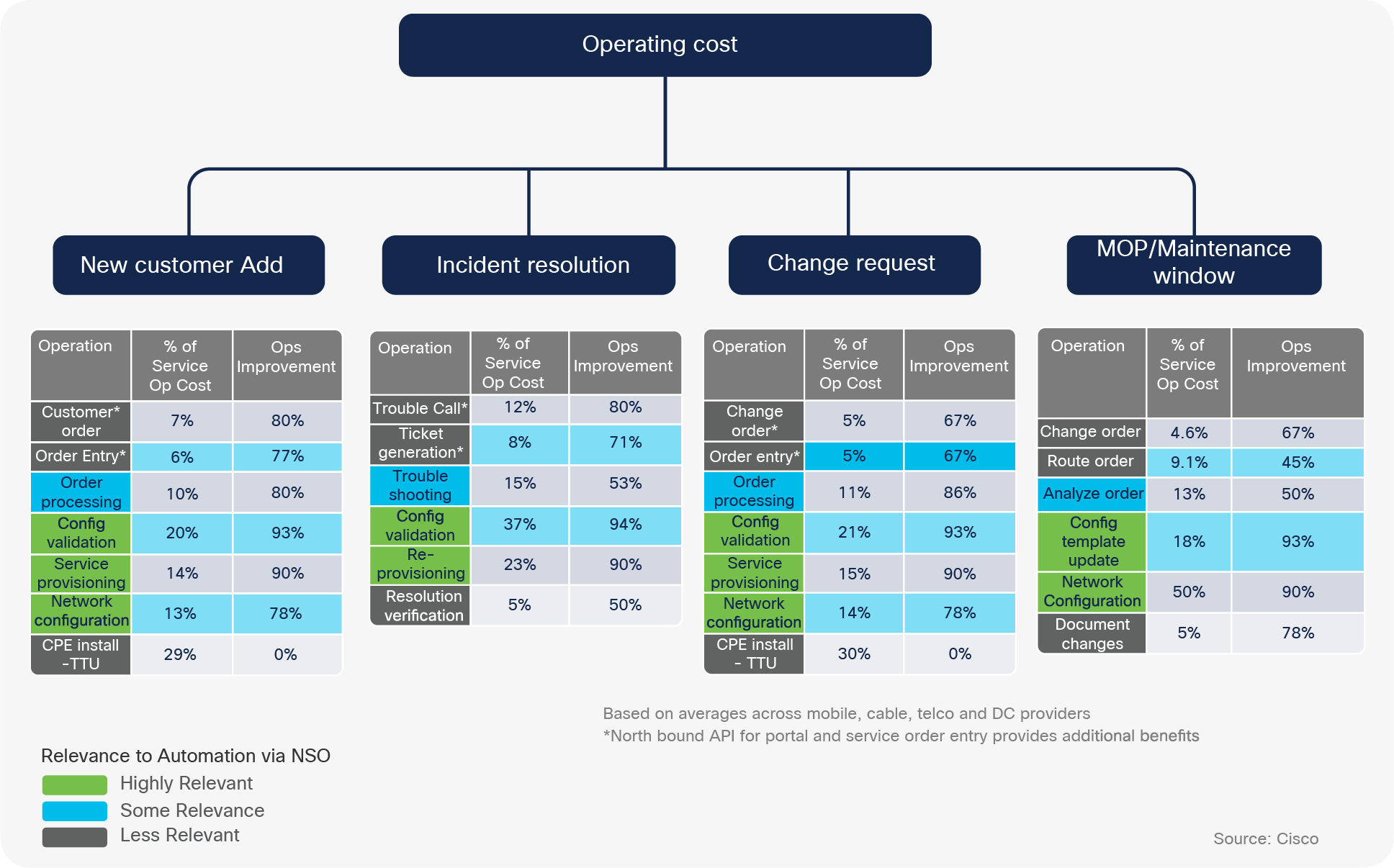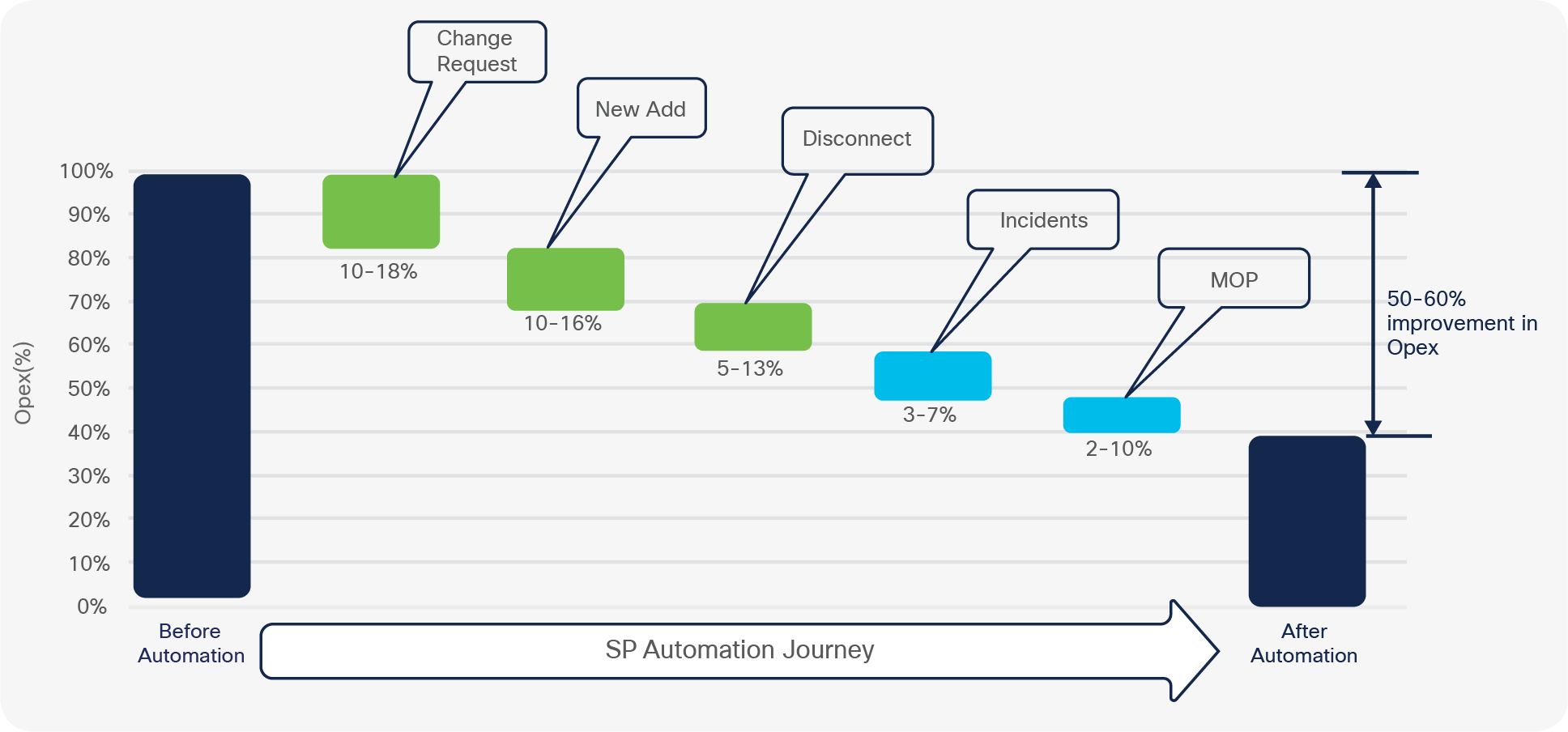The Business Benefits of Automation and Orchestration White Paper
Available Languages
Bias-Free Language
The documentation set for this product strives to use bias-free language. For the purposes of this documentation set, bias-free is defined as language that does not imply discrimination based on age, disability, gender, racial identity, ethnic identity, sexual orientation, socioeconomic status, and intersectionality. Exceptions may be present in the documentation due to language that is hardcoded in the user interfaces of the product software, language used based on RFP documentation, or language that is used by a referenced third-party product. Learn more about how Cisco is using Inclusive Language.
Automation and orchestration bring a significant benefit to service providers as they seek to avoid cost and improve revenue.
Cisco completed a research study on the operational processes of major service provider customers that have automated their network environment and their real-world business outcomes. The results are compelling with the analysis showing how service providers can address one of their biggest challenges: reducing high operational costs. These operational cost benefits span legacy, hybrid, and virtual services and infrastructure.
Big reductions in OpEx confirmed
Automation and orchestration of network services are fast becoming a primary area for service providers to tackle as they seek to deliver services more quickly at reduced costs to compete with Over-The- Top (OTT) and cloud service providers.
Service providers are also preparing for the next big rise in data consumption driven by Cloud, IoT and 5G with a multi-fold surge in bandwidth demand. Service providers will need to redesign their network architecture to respond to customer demands for robust networks with high speeds and bandwidth, and reliable connectivity. However, this comes at the cost of increased operational complexity and network capacity variability. By leaving things as they are, Service Providers are faced with exponentially rising operational and capital expenses.
Automation of converged and transport networks offer a solution here to simplifying network operations and optimizing management workloads; giving you the ability to rapidly launch new revenue-generating services, reduce network TCO, and meet high customer expectations.
For Cisco’s part, we have been promoting the benefits of these features as part of programmable networks for the past several years. The benefits touted might once have sounded remote and unrealistic. Concepts such as faster time to market; simpler network operations requiring fewer highly skilled resources, resulting in improved cash flow; and a better competitive position at lower Operational Expenditures (OpEx) all seemed unattainable.
Now the results are in, and they’re really impressive. The promises of automating and orchestrating network services have become reality.
Cisco crunched the data on operational processes from some of our major service provider customers that have automated its environment. Specifically, these service providers implemented the Cisco® Network Services Orchestrator. Individual service lifecycle processes were analyzed: adding a new customer, resolving an incident, handling a change request, disconnecting a service, and managing a Maintenance Operations Process (MOP).
The overall savings in time and motions ranged from 60 to 70 percent, with the related OpEx avoidance from 50 to 70 percent. Over five years, that translated to an ROI of 383 percent and savings of $3 to $16.7 million for Tier 3 to 5 providers. The data for Tier 1 and 2 operators shows an estimated savings over five years that exceed $70 million.
These are significant results indeed.
Where the greatest savings occur
Aside from looking at the big picture, our study also isolated the cost avoidance from specific portions of workflows. The green boxes in Figure 1 below highlight where network services automation and orchestration had the greatest effects.
In the past, subject matter experts configuring half a dozens sites had to do so manually. They had to check and recheck configurations. Yet a huge percentage of problems are caused by incorrect configuration or moving back to an original configuration.
By contrast, automation and orchestration rely on the data model–driven programmatic configuration of all elements (multivendor) participating in a service—both physical and virtualized functions, traditional and Software-Defined Networking (SDN) management interfaces, operation support systems and business support systems—in a single transaction. That configuration extends from service-level parameters through the automated configuration of every network device involved in the service.
Automated configuration validation, a major area of savings in our study, extends across service chains, all the way from the customer premises equipment to the virtual network functions in the data center. The orchestrator knows if it can move on to the ongoing assurance phase of the service lifecycle (or whether it needs to reconfigure or redeploy something that has failed) based on actual measurements of performance at the endpoint. This results in a much higher first-time-right rate and improved service quality.

Source: Cisco research based on averages across mobile, cable, telco, and data center service providers.
OpEx Reduction and Efficiency Via Network Automation
The providers participating in this study have automated the entire lifecycle of their services, including fulfillment, activation testing, and ongoing monitoring and assurance. They design, deliver, and assure services more quickly. They have a single networkwide interface to all network devices and services, both physical and virtual, using a common modeling language and data store. Services are defined using the standardized YANG modeling language and mapped to device models. And everything is automated.
Goodbye to custom coding or service disruptions. Hello to operations in real time without manual intervention for incredible ROI and OpEx savings.
Automation and orchestration features are part of the Cisco Crosswork integrated portfolio for service providers. The architecture represents an infrastructure transformation that leaves past approaches to software, hardware, services, architectures, and operations far behind.
Starting the automation and orchestration journey
As you embark on the journey to automate and orchestrate your network operations, the obvious question you might have is “Where do I start?” As our study shows, we can help analyze and isolate the areas that have the biggest effects on your business, as shown in Figure 2. At the end of our analysis, we provide a summary of the OpEx savings so you can make your investment decisions. So reach out to your Cisco account representative so we can help make your journey easier or visit https://www.cisco.com/go/crosswork.

Source: Cisco research based on averages across mobile, cable, telco, and data center service providers.
Impact of Network Automation on SP OpEx